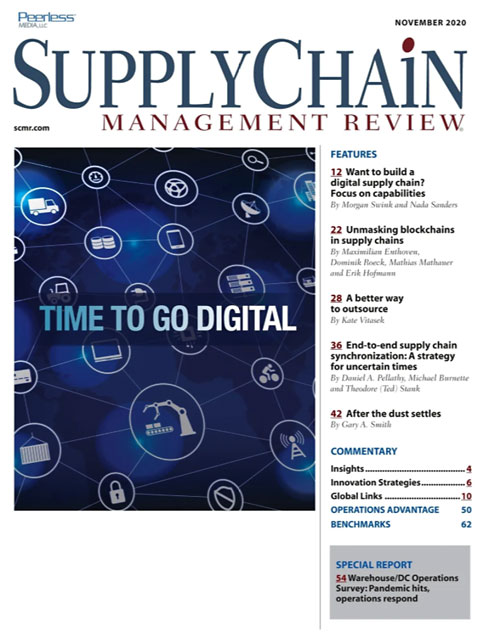Sorry, but your login has failed. Please recheck your login information and resubmit. If your subscription has expired, renew here.
November 2020
Supply chains have been in the spotlight like never before over the last eight months. That hasn’t always been a good thing. The perception, reinforced by shortages of products essential to our daily lives, is that supply chains were not up to the task and failed. The reality, as argued by MIT’s Yossi Sheffi in his new book, “The New (Ab)Normal: Reshaping Business and Supply Chain Strategy Beyond COVID-19,” is that supply chains performed as designed—they did what we expected them to do. Browse this issue archive.Need Help? Contact customer service 847-559-7581 More options
Executives across all industry sectors are rapidly adapting organizational strategies and structures to “digitally transform” their supply chains. Multiple factors are driving supply chain digitalization, including the growth of big data, artificial intelligence (AI), robotics and the Internet of Things (IoT). Some organizations are combining these advances with developments in hardware (e.g., servomechanisms) and software (e.g., analytics) to improve supply chain processes. Yet many supply chain managers are operating in a “wait-and-see” mode when it comes to digitalization.
Digital capabilities
Over the past three years we have studied the state-of-the-art of digital supply chain transformation to understand the factors that enable successful transformation as well as the obstacles that impede development. We conducted in-depth interviews with senior leaders of over a dozen large companies, all household names, across a range of industry sectors. We then conducted deep case studies in two companies, one a major airline, the other a leading consumer electronics firm. Through multiple site visits, data gathering efforts and analysis, we observed and participated in the process of digitalization at these firms.
Our findings point up three key factors that separate leading firms from laggards. First, successful transformation efforts build upon a set of common underlying features that differentiate a digital supply chain from a traditional supply chain. Second, more advanced firms pursue visions of digital maturity that follow a natural progression of core attributes. Third, and perhaps most important, successful leaders strategically target well-defined capabilities. Many supply chain leaders make the mistake of focusing on technological solutions rather than building capabilities. Our key takeaway is that companies need to focus less on the technologies themselves and more on the capabilities they enable.

This complete article is available to subscribers only.
Log in now for full access or start your PLUS+ subscription for instant access.
SC
MR
Sorry, but your login has failed. Please recheck your login information and resubmit. If your subscription has expired, renew here.
November 2020
Supply chains have been in the spotlight like never before over the last eight months. That hasn’t always been a good thing. The perception, reinforced by shortages of products essential to our daily lives, is that… Browse this issue archive. Access your online digital edition. Download a PDF file of the November 2020 issue.Executives across all industry sectors are rapidly adapting organizational strategies and structures to “digitally transform” their supply chains. Multiple factors are driving supply chain digitalization, including the growth of big data, artificial intelligence (AI), robotics and the Internet of Things (IoT). Some organizations are combining these advances with developments in hardware (e.g., servomechanisms) and software (e.g., analytics) to improve supply chain processes. Yet many supply chain managers are operating in a “wait-and-see” mode when it comes to digitalization.
Digital capabilities
Over the past three years we have studied the state-of-the-art of digital supply chain transformation to understand the factors that enable successful transformation as well as the obstacles that impede development. We conducted in-depth interviews with senior leaders of over a dozen large companies, all household names, across a range of industry sectors. We then conducted deep case studies in two companies, one a major airline, the other a leading consumer electronics firm. Through multiple site visits, data gathering efforts and analysis, we observed and participated in the process of digitalization at these firms.
Our findings point up three key factors that separate leading firms from laggards. First, successful transformation efforts build upon a set of common underlying features that differentiate a digital supply chain from a traditional supply chain. Second, more advanced firms pursue visions of digital maturity that follow a natural progression of core attributes. Third, and perhaps most important, successful leaders strategically target well-defined capabilities. Many supply chain leaders make the mistake of focusing on technological solutions rather than building capabilities. Our key takeaway is that companies need to focus less on the technologies themselves and more on the capabilities they enable.
SC
MR


Latest Supply Chain News
- Retail sales see gains in October, reports Commerce and NRF
- Balancing green and speed: Home delivery insights from the pandemic era
- AdventHealth named top healthcare supply chain by Gartner
- Geopolitical readiness in supply chains: Strategic challenges for leaders
- Unlocking retention: The role employee engagement plays
- More News
Latest Podcast

 Explore
Explore
Software & Technology News
- Nine questions are the key to AI success in building resilient supply chains
- Looking back at NextGen 2024
- AI is moving omnichannel closer to the customer
- How technological innovation is paving the way for a carbon-free future in logistics and supply chains
- Körber Supply Chain Software’s Craig Moore says MercuryGate acquisition is about the customer
- Robotic use grows by 10%
- More Software & Technology
Latest Software & Technology Resources

Subscribe

Supply Chain Management Review delivers the best industry content.

Editors’ Picks





